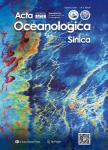Distributions of surficial sediments and its response to dynamic actions in the Xiamen Bay sea area, China
Distributions of surficial sediments and its response to dynamic actions in the Xiamen Bay sea area, China作者机构:National Engineering Laboratory of Port Hydraulic Construction Technology Tianjin Research Institute of Water Transport Engineering Key Laboratory of Engineering Sediment of Ministry of Transport Tianjin Research Institute of Water Transport Engineering State Key Laboratory of Estuarine and Coastal Research East China Normal University School of Science Tianjin University of Technology
出 版 物:《Acta Oceanologica Sinica》 (海洋学报(英文版))
年 卷 期:2016年第35卷第4期
页 面:9-18页
核心收录:
学科分类:070704[理学-海洋地质] 0709[理学-地质学] 07[理学] 0707[理学-海洋科学]
基 金:The Open Research Fund of State Key Laboratory of Estuarine and Coastal Research under contract No.SKLEC-KF201508 the Western Traffic Construction Technology Projects of the Ministry of Transport of China under contract No.2007-353-X02-160 the National Natural Science Foundation of China under contract No.41306033
主 题:Xiamen Port Jiulongjiang Estuary Xiamen Bay surface sediments grain size dynamic response
摘 要:Sediment distribution is important for morphodynamic evolution and shoreline changes in coastal zones and estuaries. In the study, the data of 230 surface sediment samples collected from the Xiamen Bay sea area in September 2008 are used to investigate the spatial distribution and sediment transport pathway. The grain size distribution of surficial sediments in the Xiamen Bay area is shown distinctly in this study. In addition, the Grain Size Transport Analysis model is used for conveying trend analysis of the sediment in this area, particularly for determining the sediment movement trend. The results indicate that eight sediment types are present for samples, with clayey silt comprising the highest percentage in the study area at 65.22%. Moreover, in the different subareas, the characteristics of grain size parameters are obviously different owing to different sediment sources and hydrodynamic conditions. Furthermore, runoff, tides, and waves are the main forces dominating sediment dynamics on the seabed and tidal flats, and the sediment movement trend is closely related to hydrodynamic conditions.



